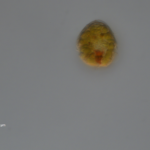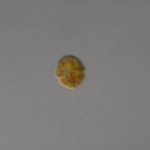Detected Species
-
HAB Species
- Diatoms
- Dinoflagellates
- Cyanobacteria
- Raphidophytes
- Haptophytes
-
Non-toxic Species
- Diatoms
- Dinoflagellates
Contact Us:
Mihaela D. Enache, Ph.D., Project Manager & Co-PI, Research Scientist I, Division of Science and Research, NJDEP (mihaela.enache@dep.nj.gov)
Ling Ren, Ph.D., PI, Research Assistant Professor, College of Science, George Mason University (lren2@gmu.edu)
Kryptoperidinium foliaceum
Morphology
Small to medium-sized thecate dinoflagellate (14–50 μm long, 11–45 μm wide); Cells extremely dorso-ventrally compressed; Rounded epitheca, round to oblong hypotheca; Multiple greenish-brown chloroplasts. A large, conspicuous red stigma in the longitudinal furrow, nucleus centrally located.
Toxins and toxicity
No toxin production recorded. However, a quasi-monospecific K. foliaceum bloom was associated with oyster mortality and metabolic distress with strong lysosomal destabilization and increased levels of glutathione in South Carolina (Lewitus et al., 2003).
Distribution and Occurrence
Europe (Britain, France, Ireland, Spain, Baltic Sea, Black Sea, Mediterranean), N. America (North Carolina, and now New Jersey). In this study, blooms of this species were observed in PGD-1, PGD-2, and OMWM-2 in summer (June and July).
References
Lewitus A.J., L.B. Schmidt, L.J. Mason, J.W. Kempton, S.B. Wilde, J.L. Wolny, B.J.Williams, K.C. Hayes, S.N. Hymel, C.J. Keppler, A.H. Ringwood. 2003. Harmful algal blooms in South Carolina residential and Golf course ponds. Population and Environment, 24, 387-413.
Lassus P.; N. Chomérat, P. Hess, E. Nézan. 2016. Toxic and Harmful Microalgae of the World Ocean / Micro-algues toxiques et nuisibles de l’ocean mondial. Denmark, International Society for the Study of Harmful Algae / Intergovernmental Oceanographic Commission of UNESCO. IOC Manuals and Guides, 68. (Bilingual English/French).


